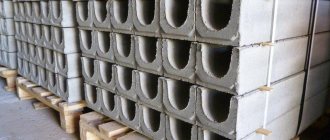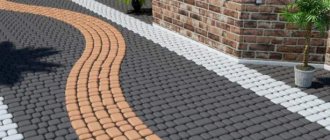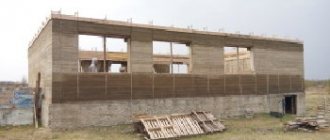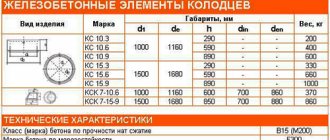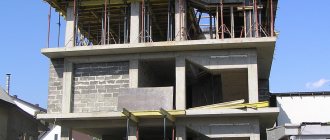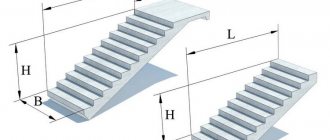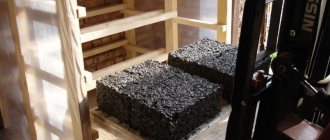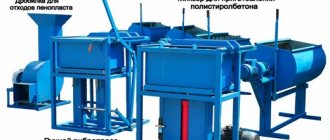Concrete flower beds are used to decorate park areas, public gardens, areas near residential buildings and public buildings, and to decorate local areas. The structures allow you to zone a site, limit wide passages, change the landscape, and create a comfortable atmosphere. Concrete flowerpots can be installed on a flat surface of paving stones, tiles, on an asphalt path or platform.
Concrete (reinforced concrete) flower beds, flower beds - manufacturing technology
Concrete flower beds are used to decorate park areas, public gardens, areas near residential buildings and public buildings, and to decorate local areas. The structures allow you to zone a site, limit wide passages, change the landscape, and create a comfortable atmosphere. Concrete flowerpots can be installed on a flat surface of paving stones, tiles, on an asphalt path or platform.
Price
For ready-made concrete flower stands, the price will be about 2.9 thousand rubles , provided that the product is made in the simplest design. Costs for massive, artistically attractive flowerpots can reach 15-30 tr . Making it yourself will cost much less.
Each craftsman can decorate his personal plot by making a concrete flowerpot or flowerpot with his own hands. The work can be carried out using improvised means, which is economically beneficial.
How to make concrete flower beds with your own hands is shown in the video instructions:
Ease of use
Concrete flower forms are made according to new designs or to order, differ in shape, size and are suitable for different types of areas and architectural styles of buildings. The concrete structure looks impressive in combination with flowering plants.
Flower stands are convenient to use due to the availability of different sizes and shapes and are displayed near houses, restaurants, and public buildings. Different varieties of flowers are planted in three-dimensional structures to create an artistic composition. Gradual sowing of flowers allows you to provide decoration for the area in the spring-summer season.
Caring for plants in concrete tubs is simple. The material does not absorb water, reliably holds the soil and is environmentally friendly. There is no need to whitewash or paint the structure regularly.
Possibilities for arranging flower beds
Concrete flower beds vary in purpose and areas for placement.
Flowerpots are produced for installation in the following places:
- Street;
- rooms;
- parks;
- greenhouses and winter gardens.
Advantages
Concrete flower beds have the following advantages:
- environmental friendliness of raw materials - the concrete composition does not evaporate harmful components under the influence of heat, does not damage plants, does not deform and does not fade from sunlight;
- the material is characterized by increased strength, because withstands exposure to precipitation and mechanical damage;
- the aesthetics of the structures is ensured by the original design of premises, squares and park areas;
- a wide palette of shades of floral shapes will allow you to choose products to match the style of the building and yard area;
- wide selection of product configurations and sizes;
- easy care of molds - products are wiped with a damp cloth or washed with water and a special detergent;
- long service life of several decades;
- versatility of designs - flower beds can be placed in different parts of the local area, planting different types of plants is allowed;
- the products have a flat bottom, ensuring stability during operation;
- the large mass of the structures prevents the possibility of theft of products;
- affordable price;
- products can have a two-tier design solution.
Some disadvantages
When using concrete flower stands, the following disadvantages must be taken into account:
- When independently making flower beds from concrete and reinforced concrete products for plants, it is necessary to use special additives to improve the performance characteristics of the composition. At the same time, the price of products increases.
- Flower beds can only be stationary, because It is difficult to rearrange the products due to the large mass.
- Raw and unpainted concrete is not suitable for all styles. Many flower beds require decorative treatment.
- The structures will need to be tinted annually.
- Many concrete planters are massive and visually reduce the space.
Flowerbed made of concrete
Cement is an economical construction raw material; the plasticity of the solution allows you to create different shapes for flower beds.
Important nuances
It is important to select or make concrete flower beds taking into account the following nuances:
- The external design of the flower bed should be combined with the planted flowering plants in color and texture. Pastel and basic colors are universal.
- Pots with plant patterns can combine the shades of flowering plants that are planned for planting.
- If you frequently change flowering plants, you need to choose a neutral color for the tub.
- It is necessary to take into account the dimensions of the flower beds. Large structures in a small area will visually narrow the space. Small vases may not fit on a spacious deck.
- The pots should have openings for water drainage to prevent damage to the plant. Technical openings for draining water flows must be provided at the stage of pouring the form with concrete mixture. However, you can drill holes in the finished structure.
- To increase the service life, it is necessary to add compositions to increase frost resistance and water-repellent additives to the concrete mixture. A container made only from sand and cement powder will last a short time.
Materials for the solution
When deciding to make the solution yourself, you need to prepare building materials and tools. The solution is prepared in a standard ratio of 1 part cement powder, 3 parts fine sand, a small amount of dye.
The concrete flower girl is painted with the following types of coloring pigments:
- Marble chips - when adding a natural coloring pigment, the surface becomes textured.
- Powder compositions - coloring pigments are intended for tinting in mass; the advantage of the method is the durability of the color. Structures tinted in the paste do not need to be painted regularly.
- Oil dyes - the material is used mixed with a solvent. The paint allows you to create the effect of a marble surface.
Formwork tools
Durable building materials with water-resistant characteristics can be used as panel floors. You can make a mold from thick cardboard, but you will need to protect the material with plastic wrap.
Manufacturing technology
The concrete flower pot is manufactured in accordance with the following steps:
- It is required to form an outer wall for the formwork.
- Then a waterproofing layer is laid.
- A hole is made for the technological opening in the bottom of the bowl.
- It is necessary to fix the container, as well as the internal border of the formwork.
- After pouring, the concrete solution must be shaken or tapped to eliminate excess air.
- The solution is covered with a film to prevent moisture evaporation.
- It is not recommended to make partitions from a concrete composition less than 3 cm. To strengthen the walls, you can use reinforcement with fiberglass or reinforced concrete structures.
- After the pouring process is completed, it takes time for the solution to harden. The composition will reach strength in 1-3 days. The hardening process will be completed in 10 days. After the specified period, the formwork is dismantled.
- Then you need to eliminate sharp bevels of the product, correct roughness and unevenness.
Decorating a flower bed
A concrete flower pot is often decorated using the following methods:
- coloring;
- creating a bas-relief;
- laying mosaic tiles, etc.
Coloring
The planter is outdoors; concrete mix urns are often painted. For the work, special waterproof dyes are used for concrete slabs, stones, and for external work. Before applying the composition, it is necessary to treat the surface with a primer in 2-3 layers.
Bas-relief
You can decorate the flowerpot using exquisite bas-reliefs. An original image on the surface can be created using plants with large leaves, pronounced veins and an original texture. After pouring and drying the composition, you can remove the plant material using water and a sponge. The veins are emphasized using tint dye.
Mosaic
The mosaic pattern on flower beds looks impressive. The tiles are fixed with quick-drying adhesive for construction work. As elements of a mosaic composition, you can use sea pebbles or shells, fragments of tiles and other moisture-resistant materials.
The work is carried out in compliance with the following sequence of steps:
- You need to draw a sketch on a sheet of paper, taking into account the direction of the surface of the tub.
- The boundaries of the image are drawn onto the surface using chalk.
- First, sections of the image borders are fixed, then the tiles are pasted into the empty space.
- The work is completed by applying clear varnish.
Concrete trees
To decorate parks and recreation areas in public gardens, trees made of concrete composition are in demand. Compositions are used to design free space and zoning areas. Products are used to decorate grottoes, suspension bridges, and are installed near benches, gazebos, children's playgrounds, and summer cafes.
Sculpted concrete is used in the manufacture of elements. Manufacturers make the work hollow, so you can use the trunks to store garden or sports equipment, or children's toys. Stumps with roots, branches, etc. can be made from concrete.
Sizes and shapes
Flower beds can be roughly divided by size , which affects their mobility. Stationary flowerpots are large-sized, imposingly heavy stationary concrete products. Rearranging such a model is difficult or even impossible. Reinforcement is often required during manufacturing. Portable ones, accordingly, are inferior in weight and dimensions.
The configuration can be very diverse - round, rectangular, etc. When making it yourself, the shape of the flowerpot will be determined by the shape of the formwork, which you can design yourself. The master can choose the most suitable product for a specific location.
Flower beds (vases, flower beds)
Concrete flowerpots are widely used in landscape design. Due to their practicality and durability, they are universal designs. Flowerpots are used as small architectural forms, decorating street space not only in urban areas, but also in private plots.
Characteristics of flowerpots and flower beds
Flowerpots mean a vase made of concrete with the addition of natural stone, which is used for planting plants.
Depending on the purpose of use, flower beds are divided into:
They come in various shapes (oval, spherical, square, polygonal, oblong, animal-shaped), and various sizes. They can be suspended, attached, portable, multi-tiered.
Comparison with metal and plastic flowerpots
Plastic flowerpots, despite their low cost, have a number of disadvantages:
- quickly lose their appearance and fade in the sun;
- subject to mechanical damage;
- some types of plastic contain harmful substances (formaldehyde) that are harmful to human health and plants;
- cannot withstand temperature changes. When exposed to low temperatures, plastic flowerpots become brittle and may crack. High temperatures soften the material and render the flowerpots unusable.
Metal flowerpots are susceptible to corrosion and need to be repainted periodically, which entails additional costs. Metal does not allow air to pass through well and gets very hot in the sun. Plants planted in metal flowerpots must be watered frequently, as the soil is susceptible to drying out quickly.
These disadvantages are absent when using concrete flowerpots, flower beds, and flower beds.
Outdoor flowerpots and flower bowls with a surface of crumbs of multi-colored natural stones have the following advantages:
- efficiency;
- durability;
- strength;
- resistance to low temperatures;
- the ability to retain moisture and temperature necessary for plant growth;
- variety of forms;
- resistance to destruction;
- environmental friendliness;
- easy to maintain, maintain aesthetic appearance, do not require painting.
Advantages of concrete flowerpots over stationary flowerbeds
Decorating city squares and streets, train stations, as well as suburban areas using concrete flowerpots is much more practical than stationary ones. This is as follows:
- It is possible to move green spaces along with flowerpots. This is convenient in unstable weather (strong wind, hail, frost), as well as if it is necessary to replace communications and other emergency situations.
- The variety of sizes and shapes of flowerpots allows you to landscape a small area.
- It makes caring for plants easier, it is easier to remove weeds, and pests from the soil do not penetrate to the roots of plants in flowerpots.
- The ability to grow fancy and ornamental plants that require special soil, since concrete can withstand an acidic environment, as well as combine different varieties of plants in multi-sectional and multi-level flower beds.
- Portable flowerpots are convenient to use when zoning an area or garden.
Application
The use of concrete flower beds in an urban environment performs the functions of landscaping areas adjacent to roads and landscaping streets. Flower beds are used as enclosing structures. Shopping centers, cafes, restaurants, hotels, offices and other institutions decorate entrance areas and parking lots with concrete flower beds. Yard areas and entrances to entrances are landscaped by planting plants in concrete flowerpots.
In suburban areas, decorating and landscaping recreation areas and terraces with the help of flower beds and concrete flowerpots is also common. It is not necessary to have a large area to use flower beds.
Euro zones indoors are most often used in administrative buildings, banks, and hotels.
In Moscow, there are a huge number of offers to choose a flower girl, flowerpots and flower beds of the desired size, shape and other parameters that will suit a specific interior. In addition, it is better to buy concrete products, since this material is environmentally friendly, reliable and harmless, and structures made from it look more dignified.
Concrete flowerpots and their use
The main areas of application of street flower girls:
- separation of pedestrian zones;
- separation of the pedestrian path from the road;
- decorating the appearance of the space.
Plants planted in such structures will be safer than in a flower bed. They cannot be trampled by street animals or damaged by careless actions of passers-by.
We can produce outdoor concrete flowerpots of any type and shape according to your desire:
- square flowerpot;
- round or oval;
- polygonal flowerpot;
- rectangular flowerpot.
As a rule, the weight of concrete outdoor flowerpots can reach 300 kg (sometimes more). Most often, heavy concrete grade B-15 M 200 is used in production.
The original flowerpot has a gray tint. At the buyer's request, we can paint the product in any color. This will make the product unique and allow you to create exactly the space design that was planned.
Flowerpots and flower beds from is a manufacturer of outdoor flowerpots made of concrete, as well as other products made of concrete and metal. We are confident in the quality of our products, so we provide a guarantee for the entire range. There is also a system of discounts and installment plans for regular customers. You can choose and buy outdoor flowerpots on our website right now. All you have to do is choose the product you like and fill out an order. Our managers will call you back to clarify the details of the order, and we will immediately begin work. You can also check prices, product availability, individual orders and delivery conditions with the managers, hotline number (free call).
We provide prompt delivery to Moscow, St. Petersburg, Tula and other cities of Russia.
How to make concrete flower stands with your own hands?
When decorating a garden plot, many people use concrete flower beds. Such products have an attractive appearance, sufficient strength, functionality and a long service life.
With their help, you can not only decorate a recreation area or sidewalk, but also zoning the space, preventing vehicles from entering or pedestrians from entering a specific area. Manufacturers offer products of various shapes and sizes. But if you want to become the owner of a unique flower girl, it is better to cast it yourself.
Why should you buy a concrete flowerpot?
Architectural concrete is a material with excellent performance properties. Concrete products stand out:
- high mechanical strength;
- durability. If you decide to buy outdoor flower beds made of concrete, you can rest assured that such products will last a long time;
- environmental friendliness;
- anti-vandal properties.
In addition, outdoor flowerpots made of concrete are very stable due to their weight, so they do not require additional fastenings. A huge variety of shapes and sizes ensures that you can choose the best option at an affordable price.
Since concrete outdoor pots are intended for planting plants, we follow certain rules during their production - for example, the design of the flowerpots ensures sufficient ventilation for the soil and the ability to drain excess liquid. Other requirements are durability, ease of maintenance, and high strength.
If you want to make your space not only functional, but also aesthetically beautiful, then outdoor flowerpots will help solve these problems.
What types of flower girls are there?
All flower stands can generally be divided into outdoor ones and those intended for indoor installation. The former are made from higher quality and durable materials.
Thus, concrete street flower beds are not afraid of exposure to moisture, sunlight and other external factors.
Installation location
The products also differ in their location in space. They can be:
- floor-mounted Installed anywhere, allow you to simultaneously grow a large number of flowers;
- hanging. Installed on a special cornice mounted on the wall;
- windowed. The place of their installation can be ebbs and window sills. If there is not enough space, special fasteners are used.
Form
The shape of the finished product can be very diverse. You can purchase a flowerpot that has a round bowl or choose a rectangular flowerpot. The outline of the manufactured product will be determined by the shape of the formwork. If you cast it yourself, you can always choose the most suitable shape for a particular location.
Product characteristics
Types of concrete flower girls
There are various types of flower beds for all kinds of shrubs and flowers.
Regardless of the location of the product, it can carry a certain functional load.
It could be:
- Territory limitation.
- Blocking the passage of vehicles.
Flower girls blocking vehicle passage
- Drawing up decorative compositions.
- Decorating the area with plants.
- Protecting flowers so they don't get trampled.
Concrete flower girls in the park
Concrete is an environmentally friendly material that does not harm health or the environment.
The table shows the advantages and disadvantages of a concrete flower girl:
| Advantages | Flaws |
|
|
Types of concrete flower girls
Flower pots differ in the way they are used.
Products can be:
- Indoor. Such flower beds are portable and standard, simple and complex in shape.
- Street concrete flower girls. The dimensions of such structures are much larger than indoor ones.
- Decorative. Their installation should be done where every centimeter of the site needs to be preserved. Such street flower beds are usually located in small courtyards.
Tip: Concrete outdoor flower stands should be made from a stronger, higher quality material that is weather resistant.
According to the method of arrangement of the product there can be:
- Floor-standing. They can be placed anywhere in the area and grow many flowers at the same time.
Floor planters
- Wall-mounted. They are located on special cornices that are securely fixed to the wall.
- Windowed. Can be found on ebbs and window sills. Used when the area of the site is limited. In this case, additional fasteners must be used.
The size and shape of the product affect their mobility and site design.
Street flower stands made of concrete can be:
- Stationary. These are large-sized, heavy concrete products. Such models are very difficult, and sometimes impossible, to rearrange. Often this is a reinforced concrete flower bowl with special reinforcement.
- Portable. They have less weight and can, if necessary, be moved to the right place.
The shape of flower beds can be: round, rectangular, curly. It all depends on the formwork form that the master can design for a specific location.
Choosing forms for a concrete flower girl
Concrete flower pot B18 can be used not only for growing flowers. Such products made of high-strength concrete can be adapted to serve as an urn.
Flower girl concrete grade B18
The shape for a concrete flower girl, a concrete flowerpot, can be selected from a wide variety of household accessories.
These can be containers of any size and configuration:
- Special products for making flower vase.
- An old plastic container of large size.
- Canister.
- Taz.
- Wooden box.
- Cardboard strong box.
Molds for making flowerpots
You can complement the shape by decorating it with stencil designs, such as shells, beautiful flowers and other details. In this case, you will need two forms: one to form the outer shell, the second - the inner part.
Technology for making flower beds and pots
Concrete flower pots can be a wonderful decoration for any recreation area. To make them you should prepare:
- empty polyethylene containers, preferably with embossed walls;
- cement. It is better to purchase a white composition;
- water;
- sand, preferably fine-grained;
- thick cardboard;
- polyethylene film;
- scotch;
- abrasive material of various grain sizes;
- knife or scissors.
Preparatory stage
The top part is carefully cut off from the plastic container with scissors or a knife. The inner part is made of cardboard. It should look like a glass. From the outside it should be wrapped with plastic film, fixing the free ends with tape. If desired, the inside can be made from a smaller plastic container.
The inside of the prepared mold should be placed on a small lid, such as a medicine bottle. This will allow you to form a hole in the bottom of the concrete product to drain water. If a suitable cover is not found, the hole can then be drilled.
Work progress
By mixing one part cement with three parts sand, a solution is prepared from which the pots will be cast. Pouring concrete is done very carefully. Bubbles must not be allowed to form.
The solution will harden in a few days. After this, the pots can be removed from the mold. Any solution deposits or other possible external defects on their surface can be easily removed using an abrasive material. First you should take coarse-grained material, and then switch to “skin” of a smaller grain size.
Pots are traditionally white and gray. If desired, you can always paint them in any desired color or even apply a bright ornament.
Technology for making flower beds
flower girl decoration
Before you start making such a product with your own hands, you need to prepare:
- Polyethylene containers, preferably with embossed walls.
- Cement, preferably white.
- Water.
- Fine sand.
- Thick cardboard.
- Polyethylene film.
- Scotch.
- Abrasive materials of different grain sizes.
- Scissors or knife.
In addition to this you will need:
- Rubber and latex gloves.
- Protective mask and goggles.
- A stick for making drainage holes, 1 cm in diameter.
- Wire brush.
To prepare concrete, it is best to use the following composition:
- 1 part Portland cement.
- From 1 to 1.5 parts of peat.
- From 1 to 1.5 parts perlite or coarse sand.
- 1 part water.
Tip: It must be borne in mind that perlite makes the construction easier, and sand allows for a smoother surface.
Before starting work, personal protective equipment is put on.
The composition can be mixed in an old basin, while:
- All dry ingredients are mixed.
- To give a certain color, pigment is introduced into the mass.
- Water is added.
- The mass is thoroughly mixed to the consistency of thick porridge.
If desired, the reinforced concrete flower girl C3 can have many tiers, but at the same time, the unity of design of all elements should be observed, as in the photo.
Multi-tiered concrete arrangement for flowers
Making a flower girl
Instructions for forming flowerpots suggest:
- Place the finished mixture in a prepared form and compact thoroughly.
- Form the bottom of the flower bowl and make drainage holes in it with a stick.
- Place the matrix on the bottom and fill the mold completely with the solution.
- Cover the workpiece with film and leave for 48 hours.
- Remove the workpiece from the mold.
- To remove irregularities, the outer surface must be treated with a wire brush.
- The flower girl should be outdoors for 3-4 weeks until it is completely dry.
We make a large product
If it is difficult to purchase a large-sized ready-made concrete flower girl due to financial problems, you can make it yourself.
Preliminary stage
You should start by determining the shape of the future product. It is better to do this in the place where the concrete flower girl will stand. The site should be cleared of debris, a contour drawn and measurements taken.
To prepare a concrete solution you will need:
- cement (fresh);
- sand. It is advisable to give preference to sifted river;
- water;
- crushed stone (fine-grained).
If you don’t have a concrete mixer, you need to prepare a container of sufficient volume and a shovel.
- sheets of plywood or unnecessary boards;
- bars for supports;
- screws or nails;
- a piece of plastic film.
Installing formwork
The contours of the assembled formwork must completely follow the contours of the finished concrete flower bed. If you purchase wavy plastic or lay small planks in a beautiful pattern, you can give the product more individuality. The plastic should be cut “along the wave” so as not to disturb the structure. If preference is given to wood, it is advisable to choose smooth boards that do not have flaws.
If you purchase special forms for flower beds made of concrete, you can completely avoid installing formwork. This will slightly increase the cost of production, but at the same time it will be possible to produce the required number of identical products. This is of fundamental importance when designing a site of large area or length.
Excavation
A trench is dug on the previously cleared site. Its depth should be up to 15 cm. The width of the trench should be equal to the thickness of the walls of the product being manufactured. The formwork material is installed along the perimeter, gradually bending it to the shape of the future concrete flower girl.
Pegs made of prepared bars are installed on the outside of the formwork to ensure sufficient rigidity of the structure. The supports should be placed at a distance of approximately 30 cm. It is also advisable to provide spacers on the outside.
Preparing the solution
When preparing the solution, it is important to observe the ratio of components. For every bucket of cement there should be three buckets of sand, a bucket of crushed stone and water. Everything is loaded into a concrete mixer and mixed until a homogeneous solution is obtained. If a concrete mixer is not available, mixing is done manually with a shovel.
Water should be added to the solution gradually. Lumps should not be allowed to form. This will not only worsen the appearance, but will reduce the strength characteristics of the finished product. The consistency of the concrete solution should be identical to “liquid sour cream”.
The final stage
The concrete solution is poured into the prepared form. To prevent exposure to precipitation, everything on top is covered with a film. After the solution has hardened (at least three days, but preferably a week), the formwork is removed and the contours of the future product are cleaned. This can be done using coarse sandpaper or other abrasive. Fine-grained will help smooth out any unevenness that appears.
Ready-made original concrete flower beds will definitely decorate your site. With their help, you can implement your own landscape design project, the center of which is a beautiful concrete structure. Taking into account the fact that all the work is carried out with one’s own hands, landscaping the site will cost significantly less than services provided by third parties.
How to make a flowerpot with your own hands
The flowerpot can become a real decoration for entrances and recreation areas. You can make such a product on your own.
The sequence of actions is revealed as follows:
- the master must prepare the area where the flowerpot will stand; the area must be level and clear of debris;
- a piece of pipe is driven into the middle of the site (to a depth of 40-50 cm), around which stones, broken bricks and other construction debris are laid out in an even semicircular mound, which will serve as a frame for the block on which the flowerpot will be built;
- the frame can be made of boards;
- a solution of sand and clay is mixed in a 1:1 ratio;
- the frame is covered with a well-kneaded mass and leveled with a trowel, forming a template for the inner surface of the product;
- in the lower part a thin blind area of clay mortar is installed, with a layer of 3-5 cm;
- a piece of pipe of smaller diameter is tightly driven into the pipe, which will serve as the axis of the structure;
- an internal template is placed on the axis, rotating it and adding clay where it is required;
- the blockhead is ready.
If the master wants to follow standard technology, he must prepare M200 concrete. The proportions of cement, sand, crushed stone are taken as 1: 2.5: 4.2
After it dries, it is rubbed with clay so that there are no cracks on the product. Wire reinforcement (d 2-3 mm) is bent along it, welding or twisting it at the intersection points. The reinforcement should be located in the middle of the wall of the future flowerpot .
The surface of the workpiece is coated with a special release agent, for which a rag or brush is used.
Recipes for processing compositions:
- 35% solution of stearin in kerosene;
- 30% wax solution in turpentine.
Stearine is melted and turpentine or kerosene is added while stirring.
Next, the wizard must do the following:
- the axis (pipe) is wrapped in 8-10 layers of newsprint to the expected level of the outer border of the flowerpot;
- on the blank, which is coated with the composition, apply a concrete solution in ½ layer, the mixture is leveled;
- prepared reinforcement is applied;
- a second layer of mortar is applied and leveled.
- a template is put on the axis to form the outer surface of the product;
- By rotating the template, the outer shape of the flowerpot is developed. The solution is added to the places where it is required to obtain a perfectly flat surface.
Ironing is carried out using the same template, the surface of the flowerpot is powdered with cement, you can use colored material . The template is rotated until a smooth surface is obtained. The finished product is covered with a damp rag and kept for a week. When the concrete is completely mature, the axle is removed from the flowerpot, turned over and put in place.
The hole that remains from the pipe will drain excess moisture. If required, a stand base can be made. During assembly, the main part is fixed on the stand using polymer concrete, and a connecting pipe is inserted into both drainage holes.
Concrete flower beds for decorating gardens and parks
For many people, flower beds and flower beds are almost the main elements in landscape design. The overall perception of a summer cottage often depends on the appearance and characteristics of these decorative structures. A variety of materials are used to make them, but concrete flower beds and similar flower beds are considered the most reliable and practical. The article will tell you their types and manufacturing features.
Functions of small architectural forms
Concrete flower beds and concrete flowerpots have become firmly established in everyday life. They can be seen on city streets, in parks, recreational areas, and on private plots.
Regardless of where the product is placed, it always carries a functional load:
- marking the boundaries of the territory;
- blocking paths for vehicles;
- modeling of decorative compositions;
- growing plants;
- protection of vegetation from accidental trampling.
Concrete is an environmentally friendly material that is not harmful to health and is safe for the environment.
Concrete garden forms: decorative urns and flowerpots
Country life is associated not only with fresh air and smoke from the barbecue, but also with an abundance of greenery and flowers, carefully cherished by housewives, and sometimes by owners. Most often, flowers are planted in flowerbeds, flowerbeds and mixborders, but decorating the local area with flowers in various hanging pots and floor/ground flowerpots is no less popular. Those who prefer homemade decor to purchased ones make their own containers for planting from scrap materials. In addition to wood, metal and various household items adapted to original flower beds, concrete is also very popular. This universal material allows you to implement almost any idea, is characterized by high strength and durability, and there are countless ways to decorate concrete flowerpots. Participants of our portal also appreciated all the advantages of concrete garden functional decor and generously share their experience.
Content
- Advantages of concrete forms.
- Composition of the mixture for filling.
- Forms for concrete flowerpots.
- Technology for filling different types of flowerpots.
Advantages of concrete forms
Due to the versatility of concrete and its resistance to any weather factors, which wood and polymers cannot boast of, objects of any shape, size and functionality, including flowerpots, are cast from it. And with the advent of various plasticizers and dyes for concrete in the public domain, it became possible not only to improve the characteristics of the solution and the finished product, but also to immediately obtain a presentable appearance. It’s no wonder that polished concrete floors, which look like an expensive, exclusive coating, are becoming increasingly popular. To make concrete flowerpots, they practically do not use ready-made adhesive mixtures, although they are presented in abundance, but rather a homemade solution based on Portland cement is mixed.
Composition of the filling mixture
- cement (usually M-500);
- sand;
- crushed stone/gravel or expanded clay (depending on the dimensions of the product, the solution may be without filler);
- water;
- modifying additives;
- pigments (optional).
It is recommended to reinforce massive flowerpots; today, instead of the usual metal, polymer fiber is often used, but you can do it the old fashioned way - mesh, metal rods, fiberglass. Another option is suitable metal products that have gone out of use, of which almost every owner has them in abundance.
Forms for concrete flowerpots
As for the forms, here, who knows, there are a lot of ready-made prefabricated and monolithic forms on sale, allowing you to get a variety of decorative flowerpots. However, their use is rare, both due to their decent cost and due to the excellent imagination of our homemade craftsmen who are able to turn almost any available device into a masterpiece.
- Containers - boxes, boxes and boxes of everything, more or less suitable.
- Plastic containers - bottles, canisters, eggplants, buckets of food and finishing materials.
- Household plastic and utensils - basins, buckets, baskets, tubs, saucepans, cups, pots, etc.
- Prefabricated forms - made of wood or metal.
- Fabric forms - burlap, towels, rectangular or oval rags.
- Things and shoes - most often children's and adult rubber boots, but there could be any old boots, shoes, or even bast shoes.
By and large, almost any object that catches your eye can become a form, if it can actually be adapted for filling at least once. They even manage to dig holes in the ground/sand, lay a film, and on top - a large leaf of burdock for texture and concrete. You can’t make a full-fledged flowerpot this way, but a bowl for succulents or decor for decoration will work out great.
One of the participants of our portal makes urns from concrete, but they can also be flowerpots if the shape is slightly modified. And in the original version, you can reorient the design for flowers.
My trash can is made of concrete - I made a trapezoid from old scraps, if you prefer, you can use a square. The size of the figure should be larger than the diameter of the container (I use a bucket) that is inserted into the middle of the wooden form. Then I nailed the wooden base to the sides of the mold. I covered the walls, the bottom of the mold and the bucket with plastic wrap and secured it with tape.
Tips for an esthete
It is advisable to make small architectural forms from concrete. This is a pliable artificial stone that can qualitatively imitate aged brick, natural stone, and other materials and textures. This is the optimal solution for any site owner who wants to combine high decorative and performance characteristics.
Ideas for choosing shapes
Landscape designers suggest using highly aesthetic concrete flowerpots not only for growing flowers. The product can be adapted to fit an urn
Forms for concrete flower beds, concrete flowerpots, can be selected from various household accessories, containers of various sizes and configurations.
Suitable forms may be:
- special products that are on sale;
- old large plastic container, canister or basin;
- sealed wooden box, durable cardboard box.
As an addition, the forms can be decorated with stencil designs, for which shells, flowers and other details are applied to their walls. You will need two forms - one will help form the outer shell, the second - the inner one .
The mold is protected with a polyethylene film for easy removal of the matrix and the finished casting. Instead of film, you can use a simple bag or cling film folded in several layers.
Among the other tools that will be needed for work, the following can be distinguished:
- latex or rubber gloves;
- safety glasses and mask;
- a stick with a diameter of 1 cm for preparing drainage holes;
- wire brush.
Ingredients for making concrete
The working mixture can be prepared according to different recipes.
However, in practice the following composition turned out to be effective:
- Portland cement – 1 hour;
- peat – 1-1.5 hours;
- perlite or coarse sand – 1-1.5 tsp. Perlite will make the structure lighter, but sand allows you to get a smoother surface;
- water – 1 tsp.
Before preparing the solution, put on gloves and personal protective equipment. You can use an old basin for mixing. First, all dry ingredients are mixed .
If desired, you can create complex multi-tiered compositions from flower beds, maintaining the unity of design of each element
If you want to add color to the mass, you can add pigment. Next, water is added and the mass is finally mixed. The consistency should resemble thick porridge.
Following actions:
- the finished mixture is placed in a pre-prepared mold and compacted;
- Initially, the bottom of the flower pot is formed, in which drainage holes are created using a stick;
- The matrix is placed on the bottom and the form is filled to the end.
The workpiece is covered with film and left for 48 hours , after which it can be removed from the mold. The outer coating can be wire brushed to remove any uneven surfaces. The flower girl should be outdoors for 3-4 weeks for complete setting .
Planting
When the product has completely hardened, you can begin planting plants. Such plantings are additionally decorated with stones, pebbles, and glass.

